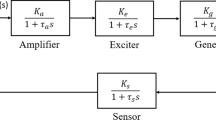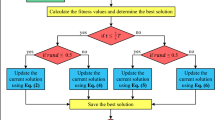Abstract
Automatic voltage regulator (AVR) is an equipment maintaining the terminal voltage of generators to a specific level all the time and under any load conditions. Many controllers for AVR system are designed based on a linearized normal model of AVR system and they are not robust enough against uncertainties such as parameter variation and load change in the system. In this paper, a gray PID (GPID) controller is designed for AVR system. The GPID controller consists of two parts, i.e. a conventional PID controller together with a gray compensation controller. In GPID controller, gray GM (0, N) model is used to estimate the uncertainties online, and a gray compensation controller is constructed according the estimation results to eliminate the effect of uncertainties. To further improve its performance, the GPID controller’s parameters are optimized through a new evolutionary algorithm, i.e., imperialist competitive algorithm (ICA). The proposed GPID controller can effectively deal with the uncertainties in AVR system. Simulation results illustrate its effectiveness of the proposed control scheme.













Similar content being viewed by others
Explore related subjects
Discover the latest articles, news and stories from top researchers in related subjects.References
Aguila-Camacho N, Duarte-Mermoud MA (2013) Fractional adaptive control for an automatic voltage regulator. ISA Trans 52(6):807–815
Atashpaz-Gargari E, Lucas C (2007) Imperialist competitive algorithm: an algorithm for optimization inspired by imperialistic competition. IEEE Congr Evol Comput 2007:4661–4667
Chatterjee A, Mukherjee V, Ghoshal S (2009) Velocity relaxed and craziness-based swarm optimized intelligent PID and PSS controlled AVR system. Int J Electr Power Energy Syst 31(7):323–333
Chiang HK, Tseng CH (2004) Design and implementation of a grey sliding mode controller for synchronous reluctance motor drive. Control Eng Pract 12:155–163
Chiang HK, Tseng CH (2004) Design and implementation of a grey sliding mode controller for synchronous reluctance motor drive. Control Eng Pract 12(2):155–163
Chou CH (2003) Synthesized variable structure control and gray prediction for a class of perturbed systems. ISA Trans 42(2):241–250
Chung CC, Chen HH, Ting CH (2010) Grey prediction fuzzy control for pH processes in the food industry. J Food Eng 96(4):575–582
Demello FP, Concordia C (1969) Concepts of synchronous machine stability as affected by excitation control. IEEE Trans Power App Syst 88(4):316–328
Deng JL (1982) Control problems of grey systems. Syst Control Lett 5:288–294
Devaraj D, Selvabala B (2009) Real-coded genetic algorithm and fuzzy logic approach for real-time tuning of proportional-integral-derivative controller in automatic voltage regulator system. IET Gener Transm Distrib 3(7):641–649
Erenturk K (2010) Gray-fuzzy control of a nonlinear two-mass system. J Frankl Inst 374:1171–1185
Gaing ZL (2004) A particle swarm optimization approach for optimum design of PID controller in AVR system. IEEE Trans Energy Convers 19:384–391
Gizi AJA, Mustafa M, Al-geelani NA, Alsaedi MA (2015) Sugeno fuzzy PID tuning, by genetic-neutral for AVR in electrical power generation. Appl Soft Comput 28:226–236
Gozde H, Taplamacioglu MC (2011) Comparative performance analysis of artificial bee colony algorithm for automatic voltage regulator (AVR) system. J Frankl Inst 348:1927–1946
Khezri R, Bevrani H (2015) Voltage performance enhancement of DFIG-based wind farms integrated in large-scale power systems: Coordinated AVR and PSS. Int J Electr Power Energy Syst 73:400–410
Krohling, R., Jaschek, H., Rey, J.: Designing PI/PID controllers for a motion control system based on genetic algorithms. In: Proceedings of the 1997 IEEE International Symposium on Intelligent Control 1997, pp 125–130 (1997)
Krohling RA, Rey JP (2001) Design of optimal disturbance rejection PID controllers using a genetic algorithm. IEEE Trans Evol Comput 5:78–82
Lu HC (2004) Grey prediction approach for designing grey sliding mode controller. IEEE Int Conf Syst Man Cybern 1:403–408
Mukherjee V, Ghoshal SP (2007) Intelligent particle swarm optimized fuzzy PID controller for AVR system. Int J Electr Power Energy Syst 77:1689–1698
Panda S, Sahub BK, Mohanty PK (2012) Design and performance analysis of PID controller for an automatic voltage regulator system using simplified particle swarm optimization. J Frankl Inst 349:2609–2625
Shayeghi H, Younesi A, Hashemi Y (2015) Optimal design of a robust discrete parallel FP + FI + FD controller for the automatic voltage regulator system. Int J Electr Power Energy Syst 67:66–75
Wang X, He Q, Chen D, Yeung D (2005) A genetic algorithm for solving the inverse problem of support vector machines. Neurocomputing 68:225–238
Wang X, He Y, Dong L, Zhao H (2011) Particle swarm optimization for determining fuzzy measures from data. Inf Sci 181(19):4230–4252
Wu Q, Hogg B (1988) Robust self-tuning regulator for a synchronous generator. IEE P-Contr Theor Ap 135(6):463–473
Yoshida H, Kawata K, Fukuyama Y (2000) A particle swarm optimization for reactive power and voltage control considering voltage security assessment. IEEE Trans Power Syst 15:1232–1239
Zhang, Y., Jiao, Z.: Study of grey PID control for discrete system. In: International Workshop on Intelligent Systems and Applications 2009 pp 1–4. IEEE (2009)
Acknowledgments
This manuscript is supported partly by the National Natural Science Foundation of China (No. 61273260), Natural Science Foundation of Hebei Province (No. F2014203208), the Specialized Research Fund for the Doctoral Program of Higher Education of China (No. 20121333120010), China Postdoctoral Science Foundation (Nos. 2013M530888, 2014T70229) and Foundation of Key Laboratory of System Control and Information Processing, Ministry of Education, P.R. China (No. SCIP2012008).
Author information
Authors and Affiliations
Corresponding author
Rights and permissions
About this article
Cite this article
Tang, Y., Zhao, L., Han, Z. et al. Optimal gray PID controller design for automatic voltage regulator system via imperialist competitive algorithm. Int. J. Mach. Learn. & Cyber. 7, 229–240 (2016). https://doi.org/10.1007/s13042-015-0431-9
Received:
Accepted:
Published:
Issue Date:
DOI: https://doi.org/10.1007/s13042-015-0431-9




